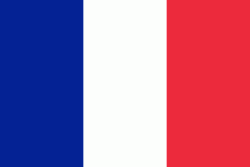Flag of Vanuatu
The flag of Vanuatu (Bislama: flaeg blong Vanuatu) was adopted on 18 February 1980.
In 1977 a flag of almost the same colours and symbolism as the future national flag was designed by local artist Kalontas Malon and adopted by the Vanua'aku Pati. When the party led the New Hebrides to independence as Vanuatu in 1980, the colours of the party flag (red, green, black and yellow) were chosen to be the basis for the national flag on Independence Day, 30 July 1980. A parliamentary committee chose the final design based on submissions from local artists.
The green represents the richness of the islands, the red symbolises blood which unites humanity as humans, and the black the ni-Vanuatu people. The Prime Minister of Vanuatu, Father Walter Lini, requested the inclusion of yellow and black fimbriations to make the black stand out. The yellow Y-shape represents the shape of Vanuatu islands on the map and the light of the gospel going through the pattern of the islands in the Pacific Ocean (approximately 83% of the people of Vanuatu profess Christianity).
The emblem in the black is a boar's tusk — the symbol of customs and tradition but also prosperity. Its worn as a pendant on the islands – along with two leaves of the local namele tree. These leaves are supposed to be a token of peace, and their 39 leaflets represent the original 39 members of the Parliament of Vanuatu.
In 1977 a flag of almost the same colours and symbolism as the future national flag was designed by local artist Kalontas Malon and adopted by the Vanua'aku Pati. When the party led the New Hebrides to independence as Vanuatu in 1980, the colours of the party flag (red, green, black and yellow) were chosen to be the basis for the national flag on Independence Day, 30 July 1980. A parliamentary committee chose the final design based on submissions from local artists.
The green represents the richness of the islands, the red symbolises blood which unites humanity as humans, and the black the ni-Vanuatu people. The Prime Minister of Vanuatu, Father Walter Lini, requested the inclusion of yellow and black fimbriations to make the black stand out. The yellow Y-shape represents the shape of Vanuatu islands on the map and the light of the gospel going through the pattern of the islands in the Pacific Ocean (approximately 83% of the people of Vanuatu profess Christianity).
The emblem in the black is a boar's tusk — the symbol of customs and tradition but also prosperity. Its worn as a pendant on the islands – along with two leaves of the local namele tree. These leaves are supposed to be a token of peace, and their 39 leaflets represent the original 39 members of the Parliament of Vanuatu.
National flag
Country - New_Hebrides
Warning: getimagesize(/Image/Map/MP2134431.gif): failed to open stream: No such file or directory in /home/mapnlee7/public_html/MAPNALL/article.php on line 532
 |
 |
The two countries eventually signed an agreement making the islands an Anglo-French condominium that divided New Hebrides into two separate communities: one Anglophone and one Francophone. That divide continued even after independence, with schools teaching in either one language or the other, and with different political parties. The condominium lasted from 1906 until 1980, when New Hebrides gained its independence as the Republic of Vanuatu.
